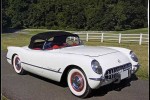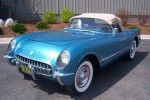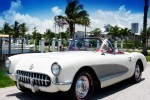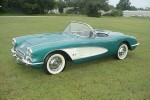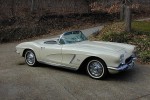This summer, we are talking “Generations”. Every week we’ve highlighted another Generation of Corvette. We have pictures, videos, and some great reading material on each Generation of Corvette. In this post, we look at the C1.
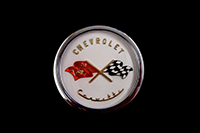
After the debut of the Corvette at the 1953 Motorama in New York, Chevrolet quickly set up a temporary facility next to the main plant in Flint, Michigan. The 300 Corvettes produced in 1953 were hand-built, painted Polo White, and had Sportsman Red interiors and black tops. Notable features of the first Corvette included the Powerglide automatic transmission, rocket-like rear fenders, a vertical front grill and sunken headlights covered by a mesh guard.
The 1954 Corvette differed very little from the ’53 although it was offered in Pennant Blue, Sportsman Red and Black in addition to Polo White. Production moved from Flint, Michigan to a renovated St. Louis assembly plant. At the time the sports car market was small, so many of the 3,640 1954 Corvettes sat on dealers’ lots for months. Many enthusiasts and reviewers thought the Corvette’s 155hp was insufficient.
One of the most important developments in the history of the Corvette was the development of the 265ci V8 engine that debuted in the 1955 Corvette. The first small block was rated at 195hp. A single Rochester four-barrel carburetor was used along with a modern 12-volt electrical system. With many 1954 Corvettes remaining unsold, GM limited production of the ’55 Corvette to 700 cars, almost all of which were powered by the new V8 engine.
The new small block V8 under the hood was greeted with great enthusiasm. Although Ford’s Thunderbird outsold the Corvette by a wide margin in 1955, GM Chairman Alfred Sloan told his board to be patient. The Corvette had just not caught the public’s imagination, but Sloan believed he could capture some of the Ford buyers.
In 1956 the Corvette underwent its first major body transformation. This new exterior helped to establish the Corvette as a true performance car. The changes included “bugeye” headlamps that were set high, sweeping concave indentations (coves) along the sides and a more rounded rear end. Curtains were replaced by roll-up door glass. A removable hardtop was offered as an option. The 1956 Corvette had the 265ci engine with an increased 210hp. A three-speed manual transmission was also offered. At this time GM began racing the Corvette and began advertising the car’s performance and competition successes.
The body of the 1957 Corvette was almost identical to the ’56. For the first time fuel injection and a manual four-speed transmission were offered. The engine size was increased to 283ci and 220hp with a single four-barrel carburetor as well. The Corvette had become a stylish performance car.
The interior and the exterior were redesigned for the 1958 Corvette. Dual headlights and simulated hood louvers were introduced. For the first time Corvette was profitable. There were four variations of the 283ci small-block engine. The Corvette had become popular, and GM built 9,168 in 1958. The 1959 Corvette was similar in appearance to the ’58 but GM removed the hood louvers and the twin chrome trunk spears. The 1960 Corvette was similar to the ’59 and the last to feature taillights formed into the rounded rear fenders.
In 1960 the popularity of the Corvette was also boosted by the premiere of a dramatic television show, Route 66, detailing the adventures of two young men traveling the country in their new 1960 Corvette. The series lasted four years, and each year the men had the newest Corvette. The rear of the 1961 Corvette was completely restyled, and the four taillight design became a Corvette tradition.
The 1962 Corvette was given a cleaner look: the coves were no longer accented by the bright trim as before, and no optional two-tone color was available. The big change was the increase in engine displacement from 283ci to 327ci. With fuel injection, the engine was rated at 360hp.
After ten years, the Corvette’s designers and engineers knew that it was time to move on. The second generation of Corvette would be dubbed the “Sting Ray.”
Content (except pictures and video): Vette Vendors

